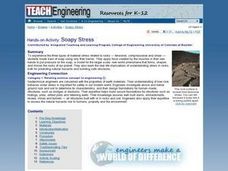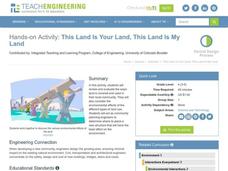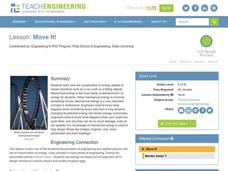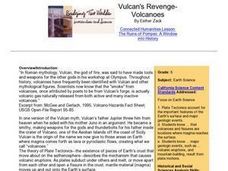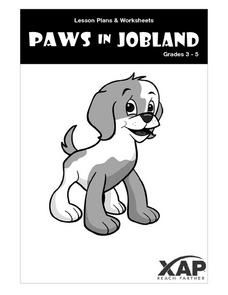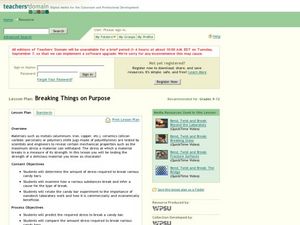Curated OER
Crossing the Narrows: Idea & Dream,...to 1937
Students decide which group they would like to be a member of discussing the Tacoma Narrowns Bridge. Each group researches the same questions but have different answers depending on the group they are in.
Curated OER
Shifting Coastlines
Young scholars study North Carolina's changing coastline during the Paleoindian and Archaic periods and determine the positions of the coastline at different times and decide what types of archaeological information has been lost due to...
Curated OER
Switches
In this switches worksheet, students solve 18 problems about types of switches, circuits, the voltage of the switches, the contact status and the number of poles and throws in switches.
Curated OER
How Should Our Gardens Grow?
Students examine different types of land use by humans and evaluate the ways land is used in their local community. They also consider the environmental effects of the different types of land use. Students assume the role of community...
Curated OER
Soapy Stress
Learners investigate the three types of material stress related to rocks. They identify the three types of stress, conduct a simulation by breaking bars of soap using only their hands, and complete a worksheet.
Curated OER
This Land Is Your Land, This Land Is My Land
Students review and evaluate the ways land is covered and used in their local community. They consider the environmental effects of the different types of land use. Students act as community planning engineers to determine where to place...
Curated OER
Environment: Wild Wind Direction
Students examine the different types of wind patterns. Using common materials, they construct weather vanes to measure and record wind direction over a two-week period. After analyzing the data, they draw conclusions about the...
Curated OER
Engineering: Simple Machines
Fourth graders participate in activities to examine how simple machines help build things. They identify the six types of simple machines. They discover how simple machines where use historically to build pyramids and how they are still...
Curated OER
Servo Motor Systems
In this electrical circuit worksheet, students answer a series of 9 open-ended questions with schematics about motors and how they are used within certain types of electrical circuits. This worksheet is printable and there...
Curated OER
Move It!
Students observe a demonstration presented by the teacher covering different types of energy. They participate in an experiment where they study numerous physics vocabulary words and visit websites that demonstrate examples of these...
Curated OER
Catering Middle-School Science: Monomers, Polymers, and Macromolecules
Students investigate foods. In this biology lesson plan, students will conduct testing on different types of foods as they learn about different molecules that make them up. Students will also learn about the shapes of the molecules.
Curated OER
Diatom Ooze
Young scholars explore seafloor sediment. In this ocean environment lesson, students describe the characteristics of different types of seafloor sediment and oozes. They compare and discuss locations of sediments and oozes by plotting...
Curated OER
English Exercises: Mysteries of Anatomy
Consider this online interactive activity as a way to practice the names that often accompany human anatomy, such as the crown of the head and the roof of the mouth. Learners select an anatomy word with a double meaning from a drop-down...
Curated OER
Student Dictionary
Third graders examine the concept of alphabetizing. They develop a class dictionary, creating definitions of themselves, and typing in their names, pronunciation, and the definitions, and inserting their picture into their document.
Curated OER
Vulcan's Revenge-Volcanoes
Sixth graders research various types of volcanoes. They explore the various emissions that come from them. Offer some explanation why some erupt by "quietly" puring lava, while others blast out chunks of rock and clouds of ash and gases.
Food a Fact of Life
Getting to Grips
Fruit fusion or dippy divers, anyone? Here's a delicious way to introduce young cooks to aspects of safe food handling and the use of food handling tools. Groups create fruits and/or vegetable salads to share with the class.
Curated OER
The Little Prince: Socratic Questioning Strategy
Challenge readers to read closer in an activity based on the Socratic questioning strategy. As kids read Antoine de Saint Éxupery's The Little Prince, they use sentence starters to ask deeper questions about the text, and...
Curated OER
Technical Writing / Siddhartha
Twelfth graders are introduced to and produce several types of technical writing. They watch a crime video and write a police report, explore websites and draft summary sentences, write a personal vision quest based on "Siddhartha" and...
Curated OER
Job Communication
Students assess the role of communication within various jobs. In this investigation lesson, students discuss the needs and types of communication in the workforce, then make their own communication device. This device is used to role...
Curated OER
Haiku
Fourth graders create a haiku. They use a digial camera and file management techniques to save work. They also use a photo editor to manipulate the pictures. Finally, they create a PowerPoint presentation of their Haiku.
Curated OER
Tacoma Narrows Bridge
Students, in groups, create a profile of different Pacific Northwest explorers. They develop PowerPoint presentations and maps to showcase their findings.
Curated OER
Strong as the Weakest Link
Students discover the types of stress that materials undergo. They examine how bridges and skyscrapers are built to withhold the tension. They create their own structure out of marshmallows and spaghetti.
Curated OER
Breaking Things on Purpose
High schoolers predict the required stress to break a candy bar. They examine how a various substances break and infer a cause for the type of break.
Students relate the candy bar experiment to the importance of nanotech laboratory work...
Curated OER
Using Art to Draw Us Together
Young scholars build their own bridges or make connections to other peers, teens, adults/parents, senior citizens and people from around the world through various art mediums. Through this type of lesson students attempt to communicate...




